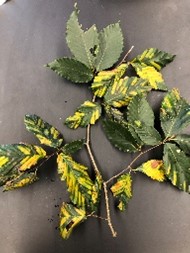 Beech Leaf Disease
Beech Leaf Disease
By Plant Health Section, VT Agency of Agriculture, Food & Markets
Since over 78% of Vermont’s forested land is owned privately there is no doubt that Vermont farmers own a portion of that forested land, as a wood lot or a sugarbush. Invasive pests that impact our forests have the potential to move in firewood or in nursery stock, as well as through natural spread. One such plant pest that made its appearance last fall in two towns in southeastern Vermont is beech leaf disease. Last July, the Vermont Agency of Agriculture, Food & Markets suggested that the public “be on the look out” for beech leaf disease (BLD), which can kill all species of beech trees. This includes American beech, the only native beech to North America, and European beech, an ornamental tree in residential landscapes and potentially used as street trees due to its majestic character. BLD is now present in all New England states and is creeping northward.
The source of BLD is a nematode, Litylenchus crenatae mccannii. As the summer progresses into fall, nematode populations present on a beech tree will increase and take up residence in leaf buds. The damage occurs in the leaf buds and in mature leaves resulting in deformed yellowed cupping, or if more advanced leathery leaves. As the disease progresses a tree may prematurely drop its leaves, and over time the lack of leaves results in branch dieback and eventual death. The spread of the disease may be caused by natural transmission due to weather (wind and rain), birds, or human aided movement. If harvesting trees, if possible, take the additional step of destroying infected plant material like branches, soil and leaves. If that is not possible, avoid transporting infected plant material off site after harvest, and don’t transport seedlings. It's always best not to move firewood, and a good practice to prevent the spread of invasive pests and/or pathogens to purchase firewood where you plan to burn it or certified heat-treated firewood.
Plant pests move on nursery stock, too. Nursery stock coming into Vermont should always be accompanied by a valid certificate of inspection, a reasonable facsimile, or other certification acceptable to the Secretary of Agriculture from the state of origin or to a federal United States Department of Agriculture, Animal Plant Health Inspection Service, Plant Protection and Quarantine (USDA, APHIS, PPQ) inspector. The certificate’s purpose is to indicate that the nursery stock is believed to be free of injurious pests or plant diseases.
If BLD is present, treatment for individual trees in a residential landscape or of street trees is possible, but there is no known method for forest-scale treatment for the nematode. When choosing a pesticide, the product must be registered in the Vermont, and the label is the law.
Please report any suspected sighting of BLD or of any other plant disease or invasive insect to Vermont Invasives by going to vtinvasives.org/get-involved/report-it
Resources
Vermont Forest Invasive Pest Status Map, Beech Leaf Disease, https://experience.arcgis.com/experience/4a3efe4febd24254947e600372793632/page/Beech-Leaf-Disease/

